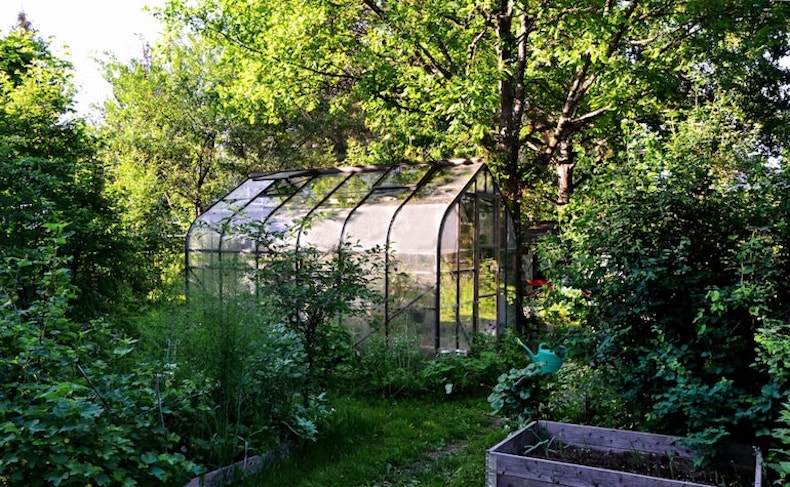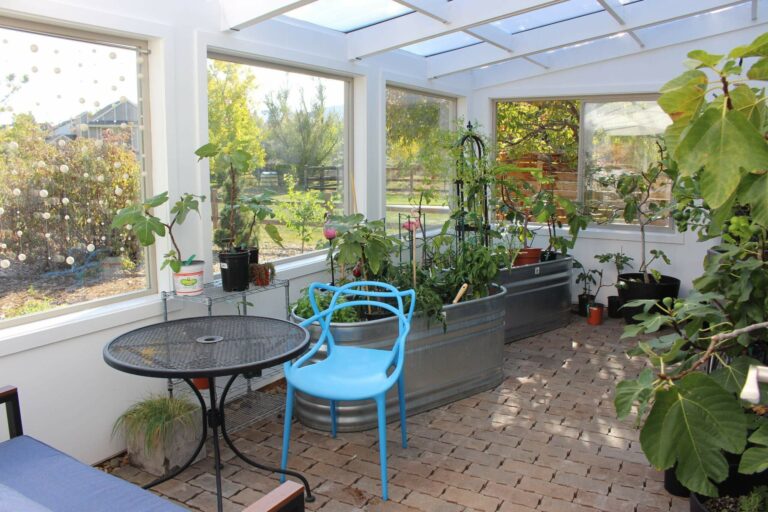A greenhouse doesn’t need full sun, but sunlight really matters for plants to grow well. Different plants like different amounts of sunlight – some like a lot, while others prefer a bit of shade. Where you put the greenhouse and which way it faces affect how much sunlight it gets. It’s good to place it where it gets plenty of sunlight during the day. But in hot places or during summer, you might need to use things like shade cloth to stop it from getting too hot inside.
However, if there’s not much sunlight where you live, special lights called grow lights can help plants get what they need. To keep things just right for plants, you might need to use fans, shades, or coolers, especially if it’s really sunny. Knowing what each plant likes for sunlight and making the greenhouse right for them is super important for plants to grow healthy and strong.
What are the key factors influencing greenhouse light needs?

These factors help greenhouse owners and horticulturists tailor light conditions to meet the specific needs of the plants grown, optimize the greenhouse’s positioning for maximum light exposure, and adapt to seasonal variations in sunlight availability.
Types of Plants Grown
Light Intensity Requirements
Different plant species have varying light requirements. Some plants, like sun-loving vegetables (tomatoes, peppers), fruiting plants, and flowering crops, thrive in full sunlight, while others, such as leafy greens or shade-tolerant herbs, can grow well in lower light conditions.
Photoperiod Sensitivity:
Some plants require specific day lengths or photoperiods to flower or fruit. For instance, short-day or long-day plants have different requirements for flowering, which impacts their light needs.
Light Quality Preferences
Certain plants might thrive under specific light spectrums (red, blue, etc.) and may respond differently to different light qualities, influencing their growth and development.
Geographic Location
Sunlight Availability
The amount and intensity of sunlight vary based on geographic location, with factors like latitude, altitude, and local weather patterns significantly affecting the quantity and quality of sunlight a greenhouse receives.
Seasonal Changes
Regions with distinct seasons experience fluctuations in daylight hours and sunlight intensity throughout the year, impacting the overall light availability for plants.
Orientation and Positioning of the Greenhouse
Orientation Relative to the Sun
Proper orientation of the greenhouse concerning the sun’s path can significantly impact the amount of light received. Optimally positioning the structure east to west allows for more uniform light exposure throughout the day.
Obstructions and Shading
Surrounding structures, trees, or geographical features can cast shadows on the greenhouse, reducing available sunlight. Assessing and minimizing potential shading sources are critical for maximizing light exposure.
Seasonal Variations
Day Length Changes
Changes in daylight hours across seasons affect the duration of light exposure for plants. Shorter days during winter can limit the amount of light available for plant growth.
Sun Angle and Intensity
The angle of the sun changes with seasons, impacting the intensity and angle at which sunlight enters the greenhouse. In winter, the sun tends to be lower in the sky, potentially reducing the penetration of light into the structure.
Do Greenhouses Need Full Sun?
Greenhouses generally benefit from full sun exposure as it provides ample light and warmth for optimal plant growth.
Advantages of Full Sunlight
Full sunlight provides the maximum amount of energy for photosynthesis, crucial for plant growth, flowering, and fruit production. Plants typically grow faster and produce higher yields when exposed to adequate sunlight.
Sunlight influences the production of vitamins in plants, leading to potentially higher nutritional value in crops. Some plants benefit from full sun exposure as it can deter certain pests and diseases.
Challenges of Full Sunlight
Full sun can cause high temperatures within the greenhouse, leading to challenges in maintaining optimal growing conditions, especially during hot seasons.
Excessive sunlight can increase evaporation, necessitating more frequent watering to maintain adequate moisture levels.
Some plant species are susceptible to sunburn or leaf damage when exposed to intense sunlight for prolonged periods.
Achieving uniform light distribution throughout the greenhouse can be challenging, leading to potential shading issues.
Suitability of Partial Sunlight for Different Plants
Certain crops like tomatoes, peppers, and many flowering plants thrive in full sun, while others like lettuce, spinach, and some herbs can tolerate partial shade.
Leafy greens, ferns, and some herbs can adapt and grow well in environments with lower light intensity, making them suitable for partial sunlight conditions.
Strategies for Maximizing Light Exposure
Properly orienting the greenhouse structure can maximize exposure to sunlight throughout the day. Reflective materials or surfaces can help redirect and amplify sunlight within the greenhouse, ensuring better coverage.
Installing adjustable shade cloth or netting allows for control over light levels, protecting sensitive plants from excessive sunlight. Supplementing natural light with artificial lighting sources such as LED or grow lights can compensate for inadequate sunlight, especially during darker seasons.
What are the ideal light conditions for greenhouse plants?

Effective management of light requirements involves a balance between providing adequate light for plant growth while considering and controlling factors like temperature, humidity, and supplementary lighting.
Ideal Light Conditions for Various Plants
Sun-Loving Plants
- Light Intensity: Sun-loving plants typically require high light intensity for optimal growth. Examples include tomatoes, peppers, cucumbers, and many flowering plants.
- Duration of Sunlight: These plants thrive in longer periods of direct sunlight, generally needing around 6-8 hours or more of direct sun exposure daily.
- Light Quality: Full-spectrum light, including ample amounts of red and blue wavelengths, is vital for the growth and development of sun-loving plants.
Shade-Tolerant Plants
- Light Intensity: Shade-tolerant plants are adapted to lower light conditions and can thrive in diffused or indirect light. Examples include leafy greens (lettuce, spinach), ferns, and some herbs like mint or cilantro.
- Duration of Sunlight: These plants can manage with shorter periods of direct sunlight and often grow well with 4-6 hours of indirect light or dappled shade.
- Light Quality: While they can adapt to lower light intensities, providing a balanced light spectrum, if possible, aids in their growth.
Balancing Light Needs with Other Factors
Temperature and Humidity
- Light and Temperature Relationship: Increased light intensity can elevate temperatures within the greenhouse. Balancing light needs with temperature control is crucial to prevent overheating.
- Humidity Considerations: High light levels can lead to increased transpiration rates, affecting humidity levels. Proper ventilation and irrigation practices are vital to maintain optimal humidity.
Artificial Lighting as Supplement
- Supplementing Natural Light: In situations where natural light is insufficient, especially during darker seasons or in regions with limited sunlight, using artificial lighting can supplement plant growth.
- Types of Artificial Lighting: LED grow lights or other supplemental lighting sources can provide specific light spectrums tailored to the needs of plants, compensating for inadequate natural light.
FAQ’s
Do greenhouses get too hot in summer?
Yes, greenhouses can get really hot in summer. The sun heats up the air and surfaces inside the greenhouse, raising the temperature. Without proper ventilation or cooling methods, the heat can become excessive.
Do tomatoes like a hot greenhouse?
Tomatoes enjoy warmth but can suffer in extreme heat. While they like warm temperatures for growth, excessive heat can stress tomato plants and negatively affect their fruit production.
Can a greenhouse overheat?
Yes, a greenhouse can overheat, especially in hot weather or if it receives too much direct sunlight. When the internal temperature rises significantly, it can harm plants, affecting their growth and health.
Are greenhouses good in hot climates?
Greenhouses can be beneficial in hot climates if managed properly. They offer control over growing conditions, allowing you to regulate temperature and humidity. However, without adequate cooling measures, greenhouses in hot climates can become too hot for plants.
How can we protect a greenhouse from the sun?
To protect a greenhouse from excessive sunlight and heat, you can use shade cloth or netting to reduce the amount of direct sunlight entering the structure. Painting or applying reflective materials to the exterior can also help reflect some sunlight away.
How can I cool my greenhouse naturally?
Natural cooling methods for a greenhouse include proper ventilation by opening doors, windows, or vents to allow airflow. Installing shade systems like awnings or using evaporative cooling techniques such as misting can also help reduce temperatures naturally.
Final Words
In summary, understanding how much light plants need in a greenhouse is super important. Some plants like lots of sunlight, while others don’t need as much. Where you put the greenhouse and the way it faces the sun really matters. Plants grow better with good sunlight. But too much sun can make it too hot inside. In places with less sunlight, special lights called grow lights help plants.
Moreover, it’s crucial to know what each plant likes for sunlight and make the greenhouse right for them. By balancing sunlight, temperature, and other things, we can help plants grow healthy and strong in the greenhouse.

